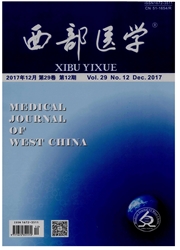

 中文摘要:
中文摘要:
目的探讨影响儿童颅脑外伤预后的不良因素。方法对自贡市第四人民医院2001年1月1日~2011年12月31日收入ICU的454例儿童颅脑损伤惠儿进行回顾性分析,包括基本资料、临床特征、生化检查、影像学检查资料等数据,其预测因素主要依据ICU医师或儿科医生评估的格拉斯哥预后评分(GOS)进行矿结果共纳入男性患儿313例(68.9%),女性患儿141例(31.1%),平均年龄(7.2±3.8)岁。出院后7个月门诊随访GOS评分结果如下:死亡82例(18.3%),植物状态5例(1.1%),严重功能缺陷15例(3.3%),中等功能缺陷71例(15.6%),恢复良好281例(61.9%)。单变量分析提示,住院期间出现低氧血症(P〈0.001)、高碳酸血症(P〈0.001)、低血压(P〈0.001)、贫血(P〈0.001)、血Na+〈125mmol/L或血Na+〉145mmol/L者(P〈0.001)、尿崩症(P〈0.001)、高温(P=0.015)、脑膜炎(P〈0.001)、败血症(P=0.006)、神经源性水肿(P=0.006)等继发性损伤或并发症,提示患儿预后不良。结论一旦患儿出现颅脑继发性损伤和并发症,预示颅脑损伤患儿的预后不良。
 英文摘要:
英文摘要:
Objective To determine the factors associated with poor outcome in children suffering traumatic head injury (HI). Methods 454 children with traumatic HI were analyzed. Basic demographic, clinical, biological and radio- logical data were recorded on admission and during the IGU stay. Prognosis was defined according Glasgow outcome scale (GOS) performed after hospital discharge by ICU and pediatric physicians. Results There were 313 male (68.9%) and 141 female patients. Mean age (±SD) was 7.2±3.8 years. The GOS performed within a mean delay of 7 months after hospital discharge was as follow: 82 deaths (18.3%), 5 vegetative states (1.1%), 15 severe disabilities (3.3%), 71 moderate disabilities (15.6M) and 281 good recoveries (61.9%). Univariate analysis showed that factors associated with poor outcome (death, vegetative state or severe disability) were hyoxemia (P〈 0. 001 ), hypercapnia (P 〈 0. 001 ), low blood pressure(P 〈 0. 001 ), anemia (P 〈 0. 001 ), blood sodium 〈 125 mmol/1 or blood sodium 〉 145 mmol/1 ( P 〈 0. 001), diabetes insipidus(P〈0. 001), high temperature(P=0.015), meningitis (P〈0. 001) and sepsis(P=0. 006)and neurogenic pulmonary edema. Conclusion The prognosis in children suffering traumatic head injury (HI) should be com- prehensively taken into account about the secondary systemic insults and complications.
 同期刊论文项目
同期刊论文项目
 同项目期刊论文
同项目期刊论文
 期刊信息
期刊信息
